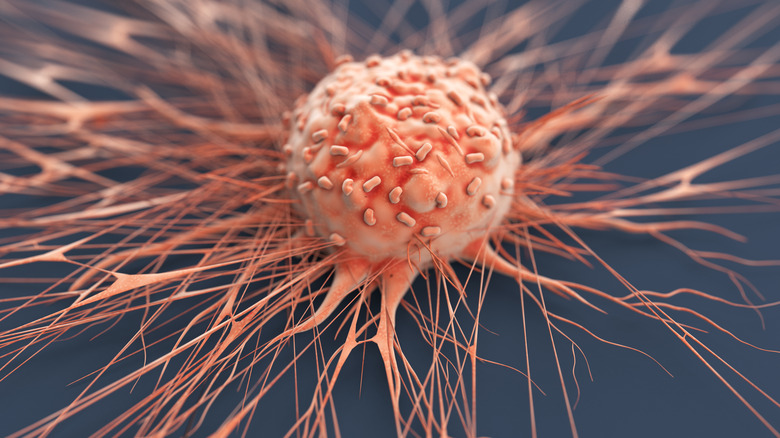10 Organs That Are Most Likely To Develop Cancer
The term "cancer" refers to a particular disease where certain cells become malignant and can spread to other parts of your body. Some of these abnormal cells may also form a collection of tissues called tumors. When doctors diagnose cancer, they classify it based on the site in which these malignant cells and tumors first began. These can include numerous different types of organ cancers, which can affect numerous different body parts, including your skin, digestive organs, certain glandular organs, and more.
While there are more than 200 known cancers that affect humans, organ cancers are those that first develop in specific organs and may spread to other parts of the body. Carcinomas are the most common types of cancers that affect organs, as these develop within the skin as well as the linings of many internal organs. Knowing the most commonly affected sites is important in helping you be aware of possible related signs and symptoms.
The skin is the most common site of cancer
The skin is your body's largest organ, and it equates to about 15% of your body weight. Without skin, your body would be left unprotected against the elements, as well as pathogens and germs. Interestingly, while the life span of skin cells is relatively short, this organ is also the most susceptible to cancers due to a simple fact: It's on the exterior of your body. Every square inch of your skin contains nearly 20 million skin cells. Some of these can turn cancerous due to alterations from UV ray exposure, but other risk factors can include radiation treatments, actinic keratosis, and immunosuppression.
Skin cancers include basal cell and squamous cell carcinomas, as well as the more dangerous melanoma, and it's not only the most common form of cancer in both females and males in the U.S., but it's also technically the most common type of organ cancer. Melanoma is the deadliest form of skin cancer due to its invasive and aggressive nature. Thanks to advances in detection and treatment, though, skin cancer has a higher survival rate compared with other organ cancers. According to data reported by the National Cancer Institute, melanoma had a 94.7% five-year relative survival rate — the percentage of people who survived at least five years after being diagnosed with a particular cancer — between 2015 and 2021.
Breast cancer is the leading female cancer
Breasts are considered "accessory organs," meaning they are not central to any particular body system. These glandular organs are nevertheless important parts of the human body (in this case, the female reproductive system). Other common examples of accessory organs include your liver and gallbladder. They all can develop cancers, as well, with the breasts being one of the most common sites of cancer, especially in women.
Aside from skin cancer, which remains the most common type of cancer among all U.S. adults, breast cancer is the is the leading cancer affecting women. In fact, the American Cancer Society estimates that 30% of all female cancers diagnosed every year are breast cancers. Due to better screenings and prompt treatments though, the five-year relative survival rates for breast cancer have significantly improved in recent years. For example, newly diagnosed breast cancer cases had an average 91% five-year relative survival rate, based on data collected from 2014 to 2020. Scientists do not know the exact causes of breast cancer, but there are several known risk factors. Among these include acquired gene mutations, the majority of which have not yet been identified.
Prostate cancer is a common concern in males
The prostate is also considered both a reproductive gland and an organ. Despite its small size, there are many issues that can develop in this male reproductive gland. The most common prostate condition is called benign prostatic hyperplasia (BPH), which is a noncancerous condition that can make the prostate grow exponentially in size. and can eventually lead to urethral blockages. BPH doesn't cause cancer, though. Prostate cancer is instead a separate — and common — type of organ cancer.
Outside of skin cancer, cancer of the prostate is the most common type in males. In fact, the American Cancer Society estimates that 1 out of every 8 men will develop prostate cancer. It's most common after the age of 65, and it can be deadly if not detected and treated early. The good news is that the number of prostate cancer deaths has declined since the 1990s thanks to prompt diagnoses and evolving treatment options — proof that ongoing cancer research has led to huge and important breakthroughs in medical science. That said, researchers are still working to determine the exact causes of prostate cancer, but current known risk factors include family history and age.
Lung cancers are not exclusive to cigarette users
Breathing is often a basic body function we take for granted, and it's easy to not think about it. None of this is possible without your lungs, though. Collectively, both lungs help to take in oxygen your body depends on, and these organs also help get rid of carbon dioxide whenever you exhale. This cycle actually takes place between 12 and 20 times every minute! Without lungs, humans simply cannot survive. Unfortunately, there are several diseases that can affect these vital organs, including lung cancer.
Lung cancer can develop in these organs due to cellular damage. The leading risk factor for this cancer continues to be smoking, and secondhand smoke is another major cause, too. If you've ever done science projects on smoking, you've also likely learned about the effects of cigarette smoking on the lungs. While lung cancer cases have been declining along with decreased rates of cigarette smoking in the U.S., it's considered a leading type of cancer overall. Outside of skin cancer, lung cancer is considered the second most prevalent type of cancer in both males and females, and it's also among the deadliest of cancers in the U.S. It isn't exclusive to people who have smoked or been exposed to cigarette smoke, either. Other possible lung cancer risk factors include air pollution and radon exposure. People with a family history of lung cancers may also be at a greater risk of developing this type of organ cancer at some point in the future.
Colon cancer is increasing among young adults
Also the longest part of the large intestine, the colon is a tube-shaped organ that helps move solid waste to your rectum and anus. This important member of the digestive system isn't without it problems, though. Some common diseases that involve the colon include irritable bowel syndrome (IBS), ulcerative colitis, and diverticulitis. Abnormal tissues called polyps can also grow on the colon, and sometimes, these can develop into cancer. Colon cancer is also referred to as "colorectal cancer," which is an umbrella term that describes any tumors that develop within the colon and rectum.
Overall, colorectal cancer is one of the most commonly diagnosed cancers in both females and males in the U.S. It's also considered the third most prevalent cause of cancer-related death. According to the American Cancer Society, there were at least 107,320 new colon cancer diagnoses in the U.S. in 2025. Since these cancers often do not cause symptoms in their early stages, medical professionals usually recommend regular colon cancer screenings starting at age 45. Unfortunately, cancers in this important organ have steadily increased among younger adults in their 20s and 30s since the 1990s. Experts believe this may be due to an increased exposure to certain colon cancer risk factors, such as eating too many processed foods and red meats, as well as a sedentary lifestyle. On the flipside, cases have dropped among older adults due to screenings and risk factor mitigation.
Cancers of the bladder are common in the U.S.
When it comes to organ cancers, the bladder might erroneously get overlooked. The bladder itself is a round, balloon-like organ that fluctuates in size based on urine storage. There are several types of conditions that may develop from bladder issues, including infections, cystitis, and incontinence. But sometimes the cells in the bladder can become malignant and then start to replicate. The most common type of cancerous cells in the bladder occur in the urothelial (transitional) cells, which are located in the lining of this organ as well as other parts of the urinary tract. This type of bladder cancer is called urothelial carcinoma.
Overall, bladder cancer is considered the fifth most prevalent cancer in the U.S., per a piece published by StatPearls. While anyone can develop bladder cancer, it's most common in males, as well as in adults over the age of 55. Other risk factors include genetics, smoking, workplace exposure to certain chemicals, and chronic bladder infections. Given the number of risk factors and high incidence, it's important to keep this organ cancer in mind and to talk with a doctor about signs your painful urination may be due to cancer.
Kidney cancers are also on the rise
As you likely learned during kidney science projects in school, your kidneys are comprised of two bean-shaped organs located behind the abdominal area. These important organs help your body filter blood to help remove waste and work with your bladder to get rid of these items via urine; the average pair of kidneys can filter an astonishing 200 quarts of fluids per day. Diseases of the kidneys can sometimes occur with certain underlying health conditions, however. These organs are also common sites of cancer, with renal cell carcinoma being the most prevalent form affecting the kidneys.
The American Cancer Society ranks kidney cancer as one of the 10 most common cancers, although it's more prevalent in males as well as adults 55 to 74 years old. It also makes up about 4% of all new cancer cases, per the National Cancer Institute (NCI). Kidney cancers diagnoses are thought to be increasing in number – not necessarily because it's more prevalent, but due to more effective diagnostic tools like computed tomography (CT) scans. At the same time, kidney cancer related deaths are declining. The NCI says this type of cancer has more than a 78% five-year relative survival rate, and that 2.3% of all 2025 cancer deaths were attributed to kidney cancer.
Cancer is a possible, but less common, form of liver disease
The liver is one of the largest internal organs in the human body, and is responsible for helping your body produce bile and store glycogen while also filtering out non-nutritive substances. Not only is the liver a vital human organ that can miraculously regenerate, but it is also unfortunately susceptible to several types of diseases. At least 100 million people in the U.S. are thought to have liver disease, but only about 4.5 million adults are currently diagnosed. Among these possible liver diseases include metabolic dysfunction-associated steatotic liver disease (or MASLD, and formerly known as non-alcoholic fatty liver disease), scarring of the liver (cirrhosis), and cancer. Untreated liver problems, including MASLD, can also cause liver cancer over time.
Liver cancer occurs when the organ's tissues develop malignant cells, and one of the most common form of liver cancer in adults is called hepatocellular carcinoma. While liver cancer isn't as common in the U.S. as other liver-related diseases, it's still considered a common cause of cancer-related death worldwide. Still, in the U.S., liver cancer accounted for over 42,000 new cases and more than 30,000 related deaths in 2025 alone, per the American Cancer Society. Unfortunately, unlike other organ cancers, liver cancer is on the rise, with new cases tripling over the last four decades.
Pancreatic cancer is challenging to diagnose and treat
You might not think about your pancreas much, as it's one of the more elusive organs in the body. It's responsible for making digestive enzymes as well as hormones that regulate blood glucose levels. While technically large in size at 6 inches long, the pancreas is a tadpole-shaped gland sits behind your stomach and is covered by other nearby organs such as the spleen and liver. This location can make it difficult to diagnose diseases of the pancreas, including cancer — in fact, it's notoriously difficult to diagnose pancreatic cancer in early, treatable stages for this exact reason.
While considered a rarer form of cancer overall, the pancreas is still ranked as one of the most common organs that can develop cancer. The National Cancer Institute estimated that there were 67,440 new cases of pancreatic cancer in 2025, as well as 51,980 related deaths. Based on data collected between 2015 and 2021, this cancer had a 13.3% five-year relative survival rate. It's also considered the third most common cause of cancer-related deaths in the U.S.
The small thyroid gland is also prone to cancer development
The thyroid is a butterfly-shaped gland that's located at the base of your neck, underneath the larynx. It's also quite small, weighing only 20 to 60 grams. Despite its size, the thyroid is responsible for numerous metabolic functions throughout the body based on the hormones it produces. (This is dependent on the functions of TSH, too.) Notably, thyroid hormones can directly affect your metabolism, heart rate, body temperature, and blood pressure. But that also means that diseases of the thyroid can be cause for concern. Sometimes the thyroid can become underactive (hypothyroidism) or overactive (hyperthyroidism) due to issues with hormone production, while certain other thyroid diseases are autoimmune-related. Less commonly, this organ can also be a site of cancer development.
Thyroid cancer is most common in middle-aged and older adults. Like pancreatic cancer, thyroid cancers are not generally considered to be especially common. However, it is still a relatively common organ cancer. In 2025, the American Cancer Society estimated a total of 44,020 new cases of thyroid cancer in the U.S., as well as 2,290 related deaths. Females are also three times more likely to develop this type of cancer than males. Unlike some of the more invasive forms of organ cancers though, thyroid cancer is considered highly treatable thanks to earlier diagnoses over the last decade.










